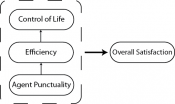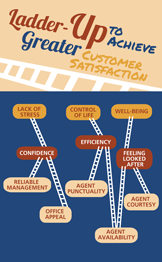Linking Service Attributes to Customer End-Goals
By Chiara Orsingher, PhD (Italy), Gian Luca Marzocchi, PhD (Italy) and Sara Valentini, PhD (Italy)
Buying a house is a complex and involving process. The process is much more significant than just deciding on a location, a space, and a set of features. The home purchase often helps fulfill a set of personal goals, requiring commitment to a long-term endeavor and projecting oneself in the future. From the customer point of view, buying a house is an all-encompassing experience, not just a purchase, and the customer's personal relationship with the real estate agent becomes an integral part of the sales experience. Consequently, many agent-related factors exert a deep influence on the customer's overall evaluation of the experience. Practitioners and researchers have long recognized the importance of this relationship and, throughout the years, have identified several real estate agents characteristics that contribute to customer satisfaction with the sales encounter. For example, agents' courtesy, punctuality, individual attention and accurate record-keeping are among the features that more strongly determine the overall perception of service quality and the future use of the firm (e.g. Seiler, Webb and Whipple 2000). While these attributes concern the concrete behaviors enacted by agents during the sales exchange, little is known about why these attributes are so relevant for the customer. Why is willingness to help important for a homebuyer? Why is accurate record-keeping important? To understand why the attributes of a relationship are important for customers, we have to understand how these attributes help customers achieve their personal goals. Goals are internal representations of desired states that customers seek to attain, and they serve as reference standards by which customers evaluate service performance. The better a real estate agent understands why and how concrete attributes relate to the personal goals of his/her clients, the better the agent will be able to satisfy the client's goals (which translates to greater financial success and personal satisfaction for the agent).
Linking Attribute Satisfaction With Goal Satisfaction
Real estate agents, therefore, need to know which goals customers use to evaluate service encounters so they can effectively tailor the sales experience to meet specific goals. Understanding customer goals, however, is not enough: agents must also understand the goal structure as a whole. Consider a customer entering a real estate agency with the proximal goal of acquiring information about a specific property or neighborhood. This goal supports a broader desire to feel confident and secure with a prospective home location, and the even broader desire to be in control of her own life. Agents and agencies should be aware that customers use the entire goal structure to assess their goal attainment and, in turn, to evaluate their level of satisfaction with the sales experience. So, the extent to which customers achieve their goals depends in part on the attributes of the service experience, which can be thought of as the means by which customers achieve their desired ends (Reynolds & Gutman 1988). Continuing with the previous example, agent punctuality and overall willingness to help are attributes that allow the customer to get information efficiently, and achieve a psychological sense of control in his life. Real estate agents should view satisfaction as the result of a process in which customers use multiple hierarchically ordered evaluation standards: attributes (e.g. punctuality), sub-goals (e.g. efficiency), and higher-order goals (e.g. control of life). During the entire service experience, customers monitor the extent to which the characteristics of the service experience help them achieve their goals. If they succeed in achieving those goals they experience a high degree of satisfaction.
Figure 1: The Effects of Attributes, Sub-Goals, and Goals on Customer Satisfaction: An Example

Why should attributes, sub-goals, and goals be jointly considered in the satisfaction evaluation? On the one hand, concentrating solely on attributes carries the risk of considering the attribute itself as the sole kind of the "reality" sought by the consumer when, in fact, the real end pursued might be a higher-order goal such as "well-being" and/or "happiness". On the other hand, an assessment that rests solely on goals might leave practitioners with no actionable tools. Thus, taking into account both attributes and goals provide an added understanding about the meaning of satisfaction, allowing for finer and more effective adjustments in the service delivery system.
Uncovering Customers' Satisfaction Path

By interpreting the entire goal structure, real estate agents are able to understand how customers use service attributes to achieve end-goals, and why these attributes are meaningful to customers. Orsingher, Marzocchi and Valentini (2011) show that this understanding can be obtained systematically through customer satisfaction survey techniques based on laddering and Mean-End Chains Theory (Reynolds and Gutman 1988). Basically, the customer should be asked to list her main reasons for satisfaction with the relationship between her and the real-estate agent and agency (e.g. punctuality, responsiveness, honesty, professionalism, etc.). Next, the customer should focus on the first given reason (i.e. punctuality) and clarify why the attribute was so meaningful to her. Then, the customer should explain why the clarification of the first given reason is so meaningful. Once the two levels have been completed, the same procedure can be repeated focusing on the second given reason (i.e. responsiveness) and so on through to the last reason. By asking the customer to climb up the ladder of her reasons of satisfaction, managers and agents can establish a thorough picture of the complex web of satisfaction paths as they are perceived by their customers. Getting to know the full web of customers' satisfaction paths can be beneficial in several different ways:
- Improve Staff Training. A deeper knowledge of customers' satisfaction paths may support service unit managers in their staff training initiatives, helping them to focus on the link existing between customer satisfaction (a frequently used corporate buzzword) and the customer as a person. Satisfying customers is not just a matter of being on time, being courteous or assuring that an office is visually appealing; it may also mean conveying a sentiment of care, confidence security, or alternatively, assuring productivity and efficiency in the transaction to realize end-goals like reducing stress, gaining control of life, achieving well-being and building self-esteem.
- Develop Better Segmentation and Customization Strategies. This approach provides agents with an opportunity to develop an in-depth understanding of different groups of customers with different satisfaction paths and hierarchical value maps, and allows management to overcome the boundaries of segmentations based on more typical demographic variables. For example, a productivity- and effectiveness-oriented customer will require a rapid greeting, an office and staff equipped with the latest technology and staff available to quickly solve problems; conversely, a relationship-oriented customer will appreciate an agent who focuses on personal attention and spends a considerable amount of time with her.
- Develop More Effective Communication Strategies. This customization effort can also be translated into effective communication processes, which can be targeted at the tangible and abstract elements that are relevant for each customer profile. For example, more effective ads should highlight the existing link between tangible characteristics of the service (e.g. agent's courtesy, professionalism, safe transactions, etc.) and the end-goals the customer wants to achieve (e.g. well-being, lack of stress, self-esteem).
- Reduce the Probability of Negative Word of Mouth. Understanding the reasons behind satisfying and unsatisfying experiences will encourage managers to identify actionable tools to increase overall client satisfaction levels. This is particularly important to reduce the probability of unsatisfying experiences and negative word of mouth that can be easily spread via the Web and that has the potential to rapidly erode brand image.
Using Consumer (Goal) Satisfaction to Improve Overall Performance
In today's Web- and customer-driven world where the opinions of unsatisfied customers about a company's services can be broadcasted instantly online, real estate agents should ensure that their efforts fully satisfied their customers. However, keeping customer satisfaction scores high may be especially difficult in an uncertain economy and in highly competitive markets, where all companies invest in increasing customer satisfaction. For this reason, it is important to understand the complex and often interrelated reasons behind customers' satisfying or unsatisfying experiences. Orsingher, Marzocchi, and Valentini (2011) show that customers are satisfied with a service provider not only because they appreciate concrete and specific attributes provided by the agency (such as agent courtesy, punctuality, updated office equipment), but also because these attributes lead them towards the attainment of more abstract, goal-related dimensions (such as well-being, self-esteem and lack of stress). In other words, customers are satisfied when (and because) they are able to achieve the personal goals they perceive as important to their lives and to the lives of their relevant others. Real estate agents should make efforts to understand the end-goals that customers seek to achieve through the home purchasing experience and which specific concrete elements can be linked to these goals. This knowledge will undoubtedly help agents increase the overall satisfaction level of their current customer base, avoid unpleasant negative word of mouth, attract new customers, create more effective communication strategies focused on end-goals, improve staff training initiatives, and eventually, increase the overall profitability of the operations they manage.
. . . . . . . . . . . . . . . . . . .
References
Orsingher, Chiara, Gian Luca Marzocchi, and Sara Valentini (2011), "Consumer (Goal) Satisfaction: A Means-Ends Chain Approach," Psychology & Marketing, 28 (7), 730-748. Reynolds, Thomas. J., and Jonathan Gutman, (1988), "Laddering Theory, Method, Analysis and Interpretation," Journal of Advertising Research, 28 (3), 11-30. Seiler, Vicky L., James R. Webb, and Thomas W. Whipple (2000), "Assessment of Real Estate Brokerage Service Quality with a Practicing Professional's Instrument," Journal of Real Estate Research, 20(1/2), 105-117.
. . . . . . . . . . . . . . . . . . .
About the Authors
Chiara Orsingher, PhD
Associate Professor of Marketing, University of Bologna, Italy
Chiara Orsingher received her PhD in Management Science from the Institut d'Administration des Entreprises of Aix-en-Provence (France). Her research interests focus on Service Management, namely Customer Satisfaction, Complaint Management and Consumer Behavior in Services, Meta-analysis, and Means-Ends Chains Theory.
Gian Luca Marzocchi, PhD
Professor of Marketing and Consumer Behavior,
Director of the Doctorate School in Economics and Statistical Science
University of Bologna, Italy
Gian Luca Marzocchi's primary research interest lies in the analysis of consumer behavior in service settings, focusing specifically on the development and testing of service quality and satisfaction models in the retail environment. He has published extensively in marketing and management scholarly journals. His refereed works have recently appeared in Journal of Applied Psychology, Psychology and Marketing, European Journal of Marketing, International Journal of Service Industry Management, Service Industries Journal, Advances in Service Marketing and Management, Entrepreneurship Theory and Practice, Journal of Operational Research Society, Journal of Management and Governance, among others.
Sara Valentini, PhD
Assistant Professor of Marketing, University of Bologna, Italy
Sara Valentini holds a PhD in management from University of Bologna (Italy). She has visited Tuck Business School (US). Her current research interests include channel choice models, multi-channel marketing, customer profitability, means-end chain theory and satisfaction with complaint handling.